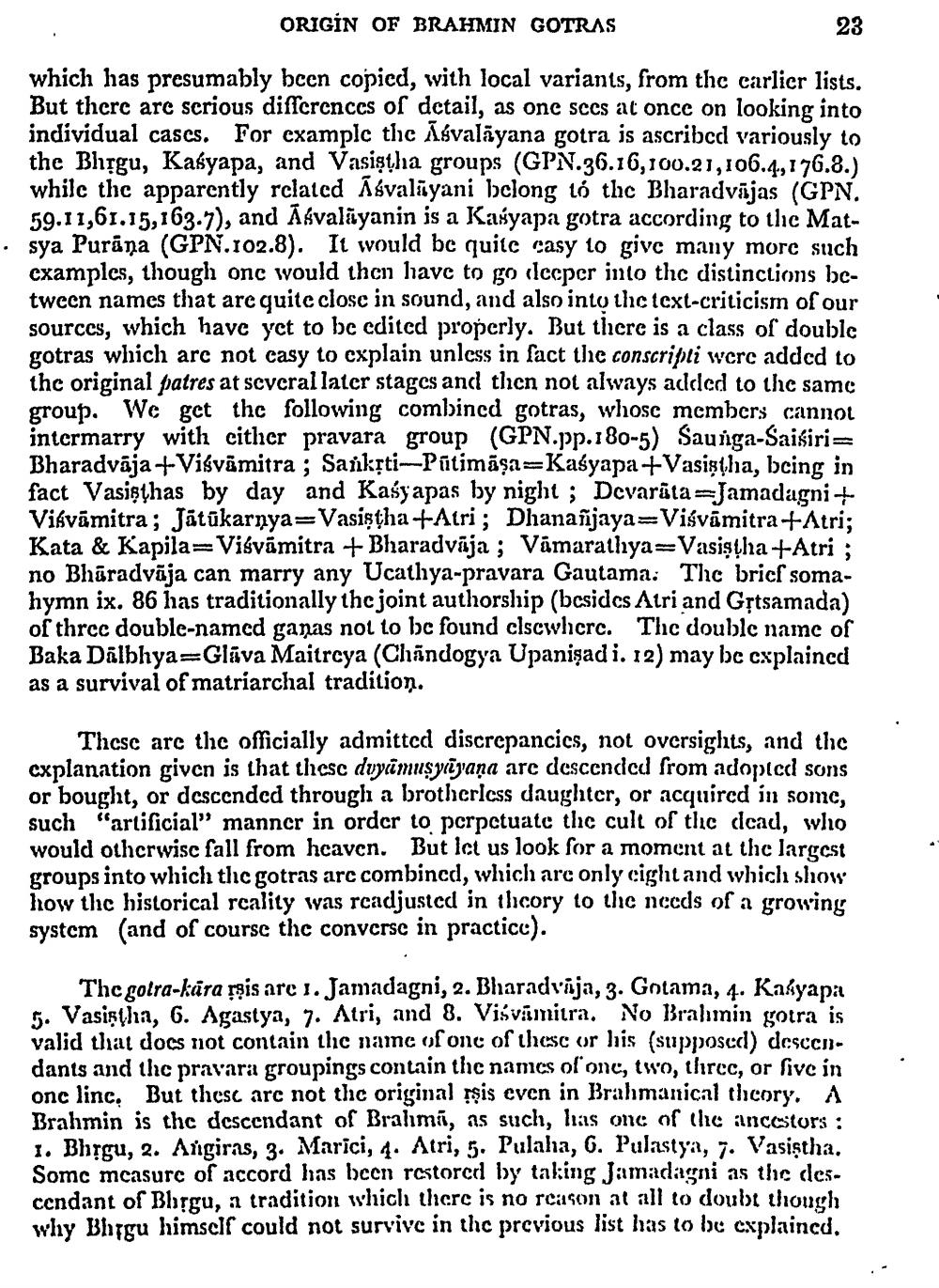Book Title: Origin of Brahmin Gotras Author(s): Dharmanand Kosambi Publisher: D D Kosambi View full book textPage 3
________________ ORIGIN OF BRAHMIN GOTRAS 23 which has presumably been copied, with local variants, from thc carlicr lists. But there arc scrious diffcrcnccs of detail, as onc sccs at once on looking into individual cascs. For examplc thc Āývalāyana gotra is ascribcd variously to the Bhřgu, Kaśyapa, and Vasiştha groups (GPN.36.16,100.21,106.4,176.8.) while the apparently rclatcd Ásvalayani Iclong to the Bharadvājas (GPN. 59.11,61.15,163.7), and Āávalīyanin is a Kasyapa gotra according to thic Matsya Purana (GPN.102.8). It would bc quilc casy to give many more such cxamples, though onc would then have to go (Iccpcr into thc distinctions bctween names that are quite closc in sound, and also into thc text-criticism of our sources, which have yet to be cditcd properly. But there is a class of double gotras which are not casy to cxplain unless in fact the conscripti wcrc added to es at scycral later stages and then not always added to the same group. We get the following combined gotras, whose members cannot intermarry with cither pravara group (GPN.pp.180-5) Saunga-Saisiri= Bharadvāja +-Visvāmitra; Sauksti-Pītimāşa=Kaśyapa+Vasiştha, bcing in fact Vasişthas by day and Kaśyapas by night ; Devarüla=Jamadagni + Vißvāmitra; Jätukarnya=Vasişthat-Atri; Dhanañjaya=Viśvāmitra +Atri: Kata & Kapila=Visvāmitra + Bharadvāja ; Vámarathiya=Vasiştha +Atri; no Bharadvāja can marry any Ucathya-pravara Gautama. Thc bricf somahymn ix. 86 has traditionally thcjoint authorship (bcsidcs Atri and Gștsamada) of thrcc double-named ganas not to bc found clscwhcrc. Thc double naine of Baka Dalbhya=Glava Maitrcya (Chándogya Upanişad i. 12) may be cxplained as a survival of matriarchal tradition. These are the officially admitted discrepancics, not oversights, and the explanation given is that thesc duymuşycīyaņa arc descended from adoplcd sons or bought, or descended through a brotherless daughter, or acquired in some, such "artificial” manncr in order to pcrpctuate the cult of thic dcad, who would otherwisc fall from hcavcn. But Ict us look for a moment at the largest groups into which thc gotras arc combincd, which arc only cight and which show how the historical rcality was rcadjusted in thicory to thc nccds of a growing system (and of course the conversc in practice). Thc golra-kära rşis arc 1. Jamadagni, 2. Bharadvija, 3. Gotama, 4. Kalyapa 5. Vasiştha, 6. Agastya, 7. Atri, and 8. Visvamitra. No Bralimin gotra is valid that does not contain thic name of one of thesc or his (supposcd) desccndants and thc pravara groupings contain the names of one, two, thrcc, or fivc in onc linc. But these are not the original rsis even in Brahmanical theory. A Brahmin is the descendant of Bralımi, as such, has one of the ancestors : 1. Bhrgu, 2. Argiras, 3. Marici, 4. Atri, 5. Pulaha, 6. Pulastya, 7. Vasiştha. Somc mcasure of accord has been restored by taking Jamadagni as the des. cendant of Burgu, a tradition which there is no rcason at all to doubt though why Bhigu himself could not survive in the previous list has to be explainca.Page Navigation
1 2 3 4 5 6 7 8 9 10 11 12 13 14 15 16 17 18 19 20 21 22 23 24 25 26 27 28 29 30 31 32 ... 59
